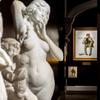So Many Choices…The Golden Age of Flatware
- January 10, 2011 10:03
Dining in the Victorian-era was truly an art form. The economic prosperity of the late 19th and early 20th centuries catapulted many into the middle and upper classes, and the desire to display just how wealthy you were was of the utmost importance to maintain, if not raise, your standing in high society. These displays took many forms, but it was the dinner party that proved to be an affair that could make or break a socialite.
Even the extravagance of the utensils you provided for guests was considered proportionate to one's wealth. The affluent demanded dining services that could meet every conceivable want and need-from fish forks and cake knives, to asparagus tongs and tomato servers. Those that were especially prized were implements used specifically for exotic foods, such as chocolate, oysters and ice cream. Before long, there soon became a utensil for every food imaginable.
This regal 306-piece Gorham flatware service in the Henry II pattern provides a complete service for 12 guests. Spoons and servers for chocolate, two different spoons for soup and broth (or bouillon), knifes and forks for fruit, three different picks for olives, nuts and pickles, it's a wonder how a dinner guest could keep it all straight which piece of flatware went with what food. Just in this service alone, your guest would have an astonishing 20 utensils at their place setting alone, not to mention the myriad of specialized servers used to get the food to their plate!
Important and prestigious jewelry and silver firms such as Tiffany & Co., Fabergé and even Cartier created some of the grandest flatware services imaginable. Some were so beautiful, custom-crafted cases were made to display these most impressive collections on a daily basis. Silver designers poured their heart and soul into creating patterns that have no equal, even today. The brainchild of legendary designer Charles T. Grosjean, Tiffany & Co.'s Chrysanthemum pattern incorporates traditional Baroque elements with a modern, natural motif of the elegant flowers that give the service its name. The sheer depth and detail of the pattern made it the firm's most expensive to produce, and a favorite of Victorian brides and socialites.
So next time you sit with family and friends for a meal, you can rest assured that no matter to what direction the dinner conversation turns, at least you know which fork, knife and spoon to use.
To see M.S. Rau Antiques' collection of fine antique flatware, click here.





















